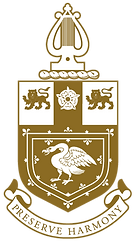This section presents the development of various Charters throughout the Company’s history. The subject is covered in detail in Richard Crewdson’s book, Apollo’s Swan and Lyre (2000), but has been summarised below by Company member Julian Cable.
The main Charters that relate to the Company are:
-
1469 Royal Charter (of Edward IV), a Charter for City-based King’s Minstrels (from Rymer’s Foedera, not in the Company’s possession)
-
1500 City Act and Ordinances, for City Minstrels
-
1604 King James Charter, for City Minstrels or Musicians
-
1950 Royal Charter

The status and validity of the earlier Charters was fraught with difficulties and challenge, with the confusion only being fully resolved by the 1950 Charter.
The 1469 Charter was the first Royal Charter in England that was granted to a body of musicians. With the turbulence of the Wars of the Roses as a backdrop, it responds to a petition to the King from the King’s Minstrels for protection against others who were falsely masquerading at festivals as trained minstrels of the King and wearing his livery. The Charter decrees to set up a Guild (or Brotherhood) to whom all minstrels must belong, on payment of a fee, if they are to practise their occupation, covering the entire kingdom (except for the County of Chester, for which a historical exemption applied). However, with time this Charter proved unworkable.
By 1500, England was enjoying greater peace, with Henry VII having finally dispatched the two pretenders to his throne. That year, a Charter was signed by the City of London Corporation that saw the former Fellowship of Minstrels become the Worshipful Company of Musicians. It dealt with concerns, similarly raised by other City guilds, that minstrels and City freemen were falling into poverty through being deprived of their living by “foreign” minstrels (lacking the freedom of the City) who were practising the same trade. The City minstrels’ main income source at the time was from the cycle of religious festivals. This Charter, like the one of 1469, refers to St Anthony as patron.
At the start of the 17th century, with London’s population expanding, the Company sought a Royal Charter to extend its control over its craft beyond City boundaries to cover a radius of three miles. A licence was approved in 1603 in the final weeks of Queen Elizabeth I’s reign, but the final Charter and a Grant of Arms were issued the following year under James I. For the first time, the office of 'Master' is stated in addition to Wardens. Two copies of the 1604 Charter exist in Guildhall Library.
In 1634, Nicholas Lanier, organiser of court masques and the first Master of the King’s Musick, asserted that the Company’s 1604 Charter was fraudulent, in disregard of the 1469 Charter (this allegation is highly contentious). The 1604 Charter was annulled in 1635.
It was not until 1950 that a new Royal Charter, granted by George VI, came into effect. It finally resolved the uncertainties about the validity of earlier charters. The Company office holds a copy of this Charter.
Click on the buttons below for further details on the Company's Charters.
: :

